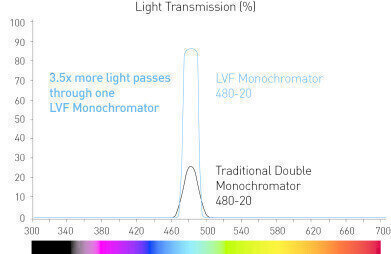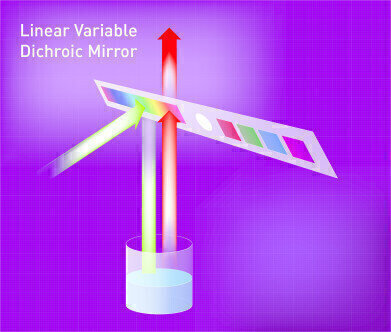-
 LVF Monochromator Light Transmission.
LVF Monochromator Light Transmission. -
 Linear Variable Dichroic Mirror.
Linear Variable Dichroic Mirror.
Laboratory Products
Microplate Readers for Proteomics and Genomics
Oct 08 2019
The sensitivity and flexibility of BMG LABTECH microplate readers make them ideal instruments for proteomic or genomic laboratories. Readers like the CLARIOstar™ Plus with spectrometer based absorbance and patented Linear Variable Filter™ (LVF) Monochromator for fluorescence and luminescence applications in plate formats up to 1536 wells are invaluable instruments for the lab.
Proteomics methods require proteins to be quantified using either absorbance methods such as Bradford, BCA, Lowry assays or using fluorescent dyes such as Nano Orange which offer increased sensitivity and specificity.
ELISAs are used to detect proteins where the signal measured is in proportion to the antibody-enzyme conjugate bound to the target of interest. Whilst absorbance is the most common format used Fluorescence and Luminescence substrates can also be used to increase dynamic range and sensitivity. Proteins can be modified in many ways including phosphorylation, methylation, acetylation, glycosylation, and ubiquitination. The effects these changes have on protein activity can be assessed using techniques such as TR-FRET, Alphascreen and Fluorescence Polarisation. Simple mix and measure assays such as TR-FRET, Alphascreen and Fluorescence Polarisation also provide great sensitivity and increased throughput compared to techniques such as RIA, ELISA and label free approaches. Microplate readers are a valuable tool in the field of genomics and are increasingly used in automated systems for the quantification of DNA/RNA. Absorbance measurements at 260nm, 280nm and 243nm are used to determine concentration and purity. The CLARIOstar™ Plus spectrometer provides the ability to acquire multiple wavelengths and spectra in one reading to provide quick and accurate readouts for this application. For techniques such as NextGen Sequencing that use low concentrations of DNA and where increased accuracy is required, fluorescence dyes such as PicoGreen/Quant-It and Qubit are recommended. For samples where concentrations are in the pg/µL range, enhancer dyes like AcuBlue can be used to accurately detect to 1pg/µL. Other genomic applications where microplate readers are used include SNP genotyping (FRET based Taqman style probes) and DNA Methylation readouts, here microplate readers offer a high throughput approach for analysis. Quick and simple data analysis is often needed; All BMG LABTECH microplate reader software includes default methods for common applications. Software is 21CFR Part11 compliant (for GLP use) and data can be automatically manipulated using templates for direct reporting or exported as raw data to integrate seamlessly into any LIMS system or calculation package for analysis offline.
More information online.
Digital Edition
Lab Asia 31.2 April 2024
April 2024
In This Edition Chromatography Articles - Approaches to troubleshooting an SPE method for the analysis of oligonucleotides (pt i) - High-precision liquid flow processes demand full fluidic c...
View all digital editions
Events
Apr 28 2024 Montreal, Quebec, Canada
May 05 2024 Seville, Spain
InformEx Zone at CPhl North America
May 07 2024 Pennsylvania, PA, USA
May 14 2024 Oklahoma City, OK, USA
May 15 2024 Birmingham, UK


.jpg)














